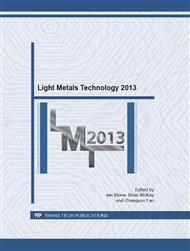[1]
J.P. Kruth, G. Levy, F. Klocke, Childs T.H.C Consolidation phenomena in laser and powder-bed based layered manufacturing. Annals of the CIRP, 56 (2007) 730-759.
DOI: 10.1016/j.cirp.2007.10.004
Google Scholar
[2]
L.E. Murr, S.A. Quinones, S.M. Gaytan, M.I. Lopez, A. Rodela, E.Y. Martinez, D.H. Hernandez, E. Martinez, F. Medina, R.B. Wicker. Microstructure and mechanical behaviour of Ti-6Al-4V produced by rapid-layer manufacturing for biomedical applications. J. Mech. Behav. Biomed. Mater. 2 (2009) 20-32.
DOI: 10.1016/j.jmbbm.2008.05.004
Google Scholar
[3]
L.E. Murr, S.M. Gaytan, D.A. Ramirez, E. Martinez, J. Hernandez, K.N. Amato, P.W. Shindo, F.R. Medina, R.B. Wicker. Metal fabrication by additive manufacturing using laser and electron beam melting technologies. J. Mater. Sci. Technol. 28 (2012) 1-14.
DOI: 10.1016/s1005-0302(12)60016-4
Google Scholar
[4]
S.M. Kelly, S.L. Kampe, Microstructural evolution in laser-deposited multilayer Ti-6Al-4V builds: Part I. microstructural characterization. Metall. Mater. Trans. A 35 (2004) 1861-1867.
DOI: 10.1007/s11661-004-0094-8
Google Scholar
[5]
T. Vilaro, C. Colin, J.D. Bartout. As-fabricated and heat-treated microstructures of the Ti-6Al-4V alloy processed by selective laser melting, Metall. Mater. Trans. A 42 (2011) 3190-3199.
DOI: 10.1007/s11661-011-0731-y
Google Scholar
[6]
L. Thijs, F. Verhaeghe, T. Craeghs, J. Van Humbeeck, J.P. Kruth. A study of the microstructural evolution during selective laser melting of Ti-6Al-4V, Acta Mater. 58 (2010) 3303-3312.
DOI: 10.1016/j.actamat.2010.02.004
Google Scholar
[7]
X. Wu, J. Liang, J. Mei, C. Mitchell, P.S. Goodwin, W. Voice. Microstrucutres of laser-deposited Ti-6Al-4V, Mater. Des. 25 (2004) 137-144.
DOI: 10.1016/j.matdes.2003.09.009
Google Scholar
[8]
F.J. Gil, M.P. Ginebra, J.A. Manero, J.A. Planell. Formation of α-Widmansttäten structure: effects of grain size and cooling rate on the Widmanstätten morphologies and on the mechanical properties in Ti6Al4V alloy, J. Alloys Compd. 329 (2001) 142-152.
DOI: 10.1016/s0925-8388(01)01571-7
Google Scholar
[9]
B. Vrancken, L. Thijs, J.P. Kruth, J. Van Humbeeck. Heat treatment of Ti6Al4V produced by Selective Laser Melting: Microstructure and Mechanical properties, J. Alloys Compd. 541 (2012) 177-185.
DOI: 10.1016/j.jallcom.2012.07.022
Google Scholar
[10]
A. Mertens, Q. Contrepois, T. Dormal, O. Lemaire, J. Lecomte-Beckers. Ti alloys processed by selective laser melting and by laser cladding : microstructures and mechanical properties, in: Proc. 12th European Conference on Space Structures, Materials and Environmental Testing, Noordwijk, The Netherlands (ESA SP-691, July 2012).
DOI: 10.4028/www.scientific.net/msf.783-786.898
Google Scholar
[11]
S.S. Al-Bermani, M.L. Blackmore, W. Zhang, I. Todd. The origin of microstructural diversity, texture, and mechanical properties in electron beam melted Ti-6Al-4V. Metall. Mater. Trans. A 41 (2010) 3422-3434.
DOI: 10.1007/s11661-010-0397-x
Google Scholar
[12]
F. Verhaeghe, T. Craeghs, J. Heulens, L. Pandelaers. A pragmatic model for selective laser melting with evaporation. Acta. Mater. 57 (2009) 6006-6012.
DOI: 10.1016/j.actamat.2009.08.027
Google Scholar


